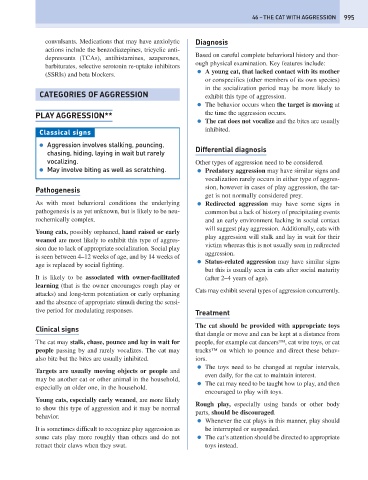Page 1003 - Problem-Based Feline Medicine
P. 1003
46 – THE CAT WITH AGGRESSION 995
convulsants. Medications that may have anxiolytic Diagnosis
actions include the benzodiazepines, tricyclic anti-
Based on careful complete behavioral history and thor-
depressants (TCAs), antihistamines, azaperones,
ough physical examination. Key features include:
barbiturates, selective serotonin re-uptake inhibitors
● A young cat, that lacked contact with its mother
(SSRIs) and beta blockers.
or conspecifics (other members of its own species)
in the socialization period may be more likely to
CATEGORIES OF AGGRESSION exhibit this type of aggression.
● The behavior occurs when the target is moving at
PLAY AGGRESSION** the time the aggression occurs.
● The cat does not vocalize and the bites are usually
inhibited.
Classical signs
● Aggression involves stalking, pouncing,
chasing, hiding, laying in wait but rarely Differential diagnosis
vocalizing. Other types of aggression need to be considered.
● May involve biting as well as scratching. ● Predatory aggression may have similar signs and
vocalization rarely occurs in either type of aggres-
sion, however in cases of play aggression, the tar-
Pathogenesis
get is not normally considered prey.
As with most behavioral conditions the underlying ● Redirected aggression may have some signs in
pathogenesis is as yet unknown, but is likely to be neu- common but a lack of history of precipitating events
rochemically complex. and an early environment lacking in social contact
will suggest play aggression. Additionally, cats with
Young cats, possibly orphaned, hand raised or early
play aggression will stalk and lay in wait for their
weaned are most likely to exhibit this type of aggres-
victim whereas this is not usually seen in redirected
sion due to lack of appropriate socialization. Social play
aggression.
is seen between 4–12 weeks of age, and by 14 weeks of
● Status-related aggression may have similar signs
age is replaced by social fighting.
but this is usually seen in cats after social maturity
It is likely to be associated with owner-facilitated (after 2–4 years of age).
learning (that is the owner encourages rough play or
Cats may exhibit several types of aggression concurrently.
attacks) and long-term potentiation or early orphaning
and the absence of appropriate stimuli during the sensi-
tive period for modulating responses. Treatment
The cat should be provided with appropriate toys
Clinical signs
that dangle or move and can be kept at a distance from
The cat may stalk, chase, pounce and lay in wait for people, for example cat dancers™, cat wire toys, or cat
people passing by and rarely vocalizes. The cat may tracks™ on which to pounce and direct these behav-
also bite but the bites are usually inhibited. iors.
● The toys need to be changed at regular intervals,
Targets are usually moving objects or people and
even daily, for the cat to maintain interest.
may be another cat or other animal in the household,
● The cat may need to be taught how to play, and then
especially an older one, in the household.
encouraged to play with toys.
Young cats, especially early weaned, are more likely
Rough play, especially using hands or other body
to show this type of aggression and it may be normal
parts, should be discouraged.
behavior.
● Whenever the cat plays in this manner, play should
It is sometimes difficult to recognize play aggression as be interrupted or suspended.
some cats play more roughly than others and do not ● The cat’s attention should be directed to appropriate
retract their claws when they swat. toys instead.

